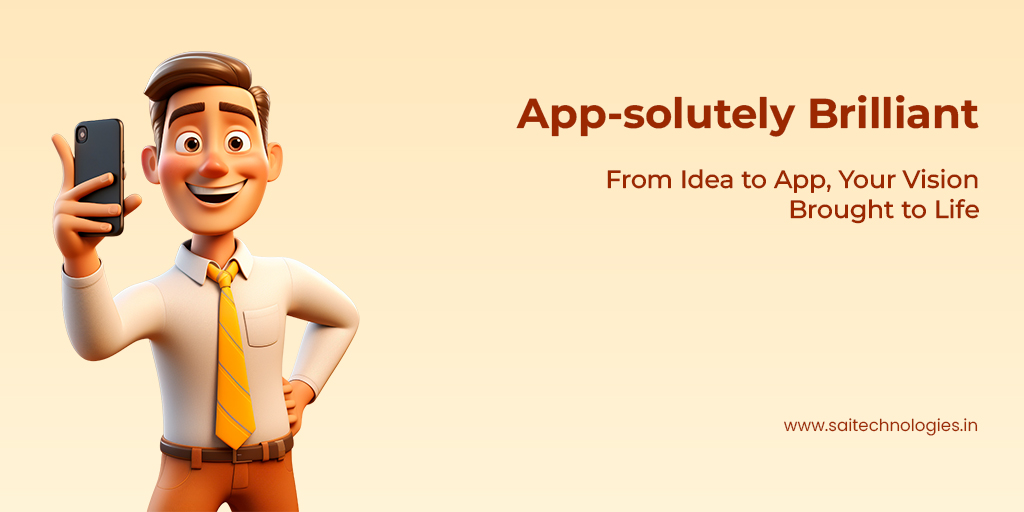App-solutely Brilliant
From Idea to App, Your Vision Brought to Life

In today's digital age, where smartphones are an extension of our lives, mobile apps have become a ubiquitous part of our daily routines. Behind every successful app is a journey that transforms an idea into a tangible reality. This article delves into the process of bringing an app idea to life – from conception to execution – highlighting the key stages, challenges, and strategies that turn visions into app-solutely brilliant creations.
Ideation: Nurturing the Seed of Innovation
Identifying a Problem:
App ideas often stem from identifying a problem or pain point that users face. This insight serves as the foundation for creating a solution that adds value to their lives.
Brainstorming and Research:
Once a problem is identified, brainstorming sessions and thorough research are conducted to explore potential solutions, identify competitors, and understand user preferences
Defining the Concept: Shaping the Vision
Defining Objectives:
Clear objectives are set for the app – what it aims to achieve and the user needs it will fulfill. These objectives guide every subsequent stage of development
User Personas:
Creating user personas helps developers understand the target audience's demographics, behaviors, and preferences, ensuring the app resonates with its intended users.
Design and User Experience: Crafting Intuitive Interfaces
Wireframing and Prototyping:
Designers create wireframes and prototypes to visualize the app's layout and flow. This stage is crucial in ensuring an intuitive and user-friendly interface.
User-Centered Design:
The design process is centered around user experience (UX), focusing on elements that enhance usability, navigation, and overall satisfaction.
Development: The Technical Transformation
Choosing the Platform:
Developers choose the appropriate platform for app development – iOS, Android, or both. They also decide whether to develop a native, hybrid, or web app.
Development and programming:
The app comes to life during the development stage. Developers write the code that dictates how the app functions, ensuring it aligns with the design and user experience.
Testing and Iteration: Refining for Perfection
Quality Assurance:
Rigorous testing is conducted to identify and rectify bugs, errors, and inconsistencies. This stage ensures that the app is functional and stable.
User Testing:
Beta testing involves real users interacting with the app to gather feedback. This feedback guides refinements that improve the overall user experience.
Launch and Deployment: Sharing the Innovation
Submission to App Stores:
The app is submitted to app stores (e.g., Apple App Store, Google Play Store) for review and approval. This step marks the official launch of the app.
Marketing and Promotion:
To ensure a successful launch, marketing strategies are employed to create buzz, attract users, and encourage downloads.
Post-Launch Strategies: Nurturing Growth
Feedback Incorporation:
User feedback continues to inform app enhancements. Regular updates based on user insights contribute to long-term success.
Analytics and Insights:
App performance is tracked using analytics tools, providing insights into user behaviors, engagement rates, and areas for improvement.
Challenges and Strategies: Navigating the App Landscape
Market Competition:
The app landscape is competitive. Thorough market research, identifying unique selling points, and continuous innovation are essential to stand out.
User Retention:
Retaining users post-download is challenging. Providing value through regular updates, relevant content, and personalized experiences fosters user loyalty.
Emerging Technologies: Future-Proofing Your App
Integration of AI and Machine Learning:
The integration of AI and machine learning enhances app functionality. From chatbots to predictive analysis, these technologies offer advanced user experiences.
Augmented Reality (AR) and Virtual Reality (VR):
AR and VR technologies open new possibilities, creating immersive and engaging app experiences that bridge the physical and digital worlds
Conclusion: Turning Dreams into Digital Realities
The journey from app idea to reality is a testament to innovation, dedication, and the power of technology. App development is a multidisciplinary process that combines ideation, design, development, testing, and strategic implementation. With a clear vision, user-centered design, and a commitment to continuous improvement, app creators can transform their ideas into app-solutely brilliant solutions that impact and enrich users' lives. As technology continues to evolve, the potential for creating transformative, game-changing apps remains boundless, offering creators the opportunity to turn their dreams into digital realities that resonate with users around the world.

